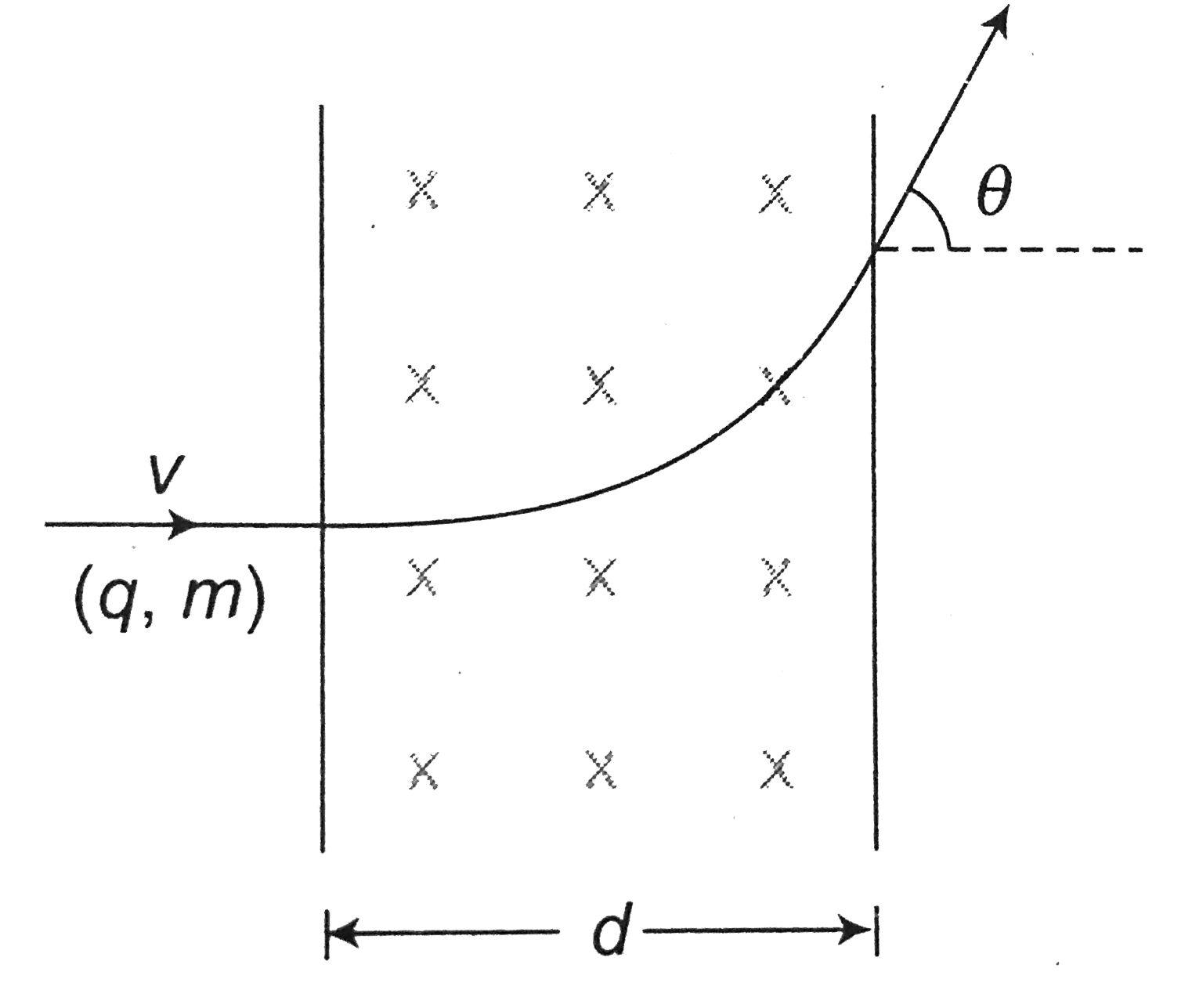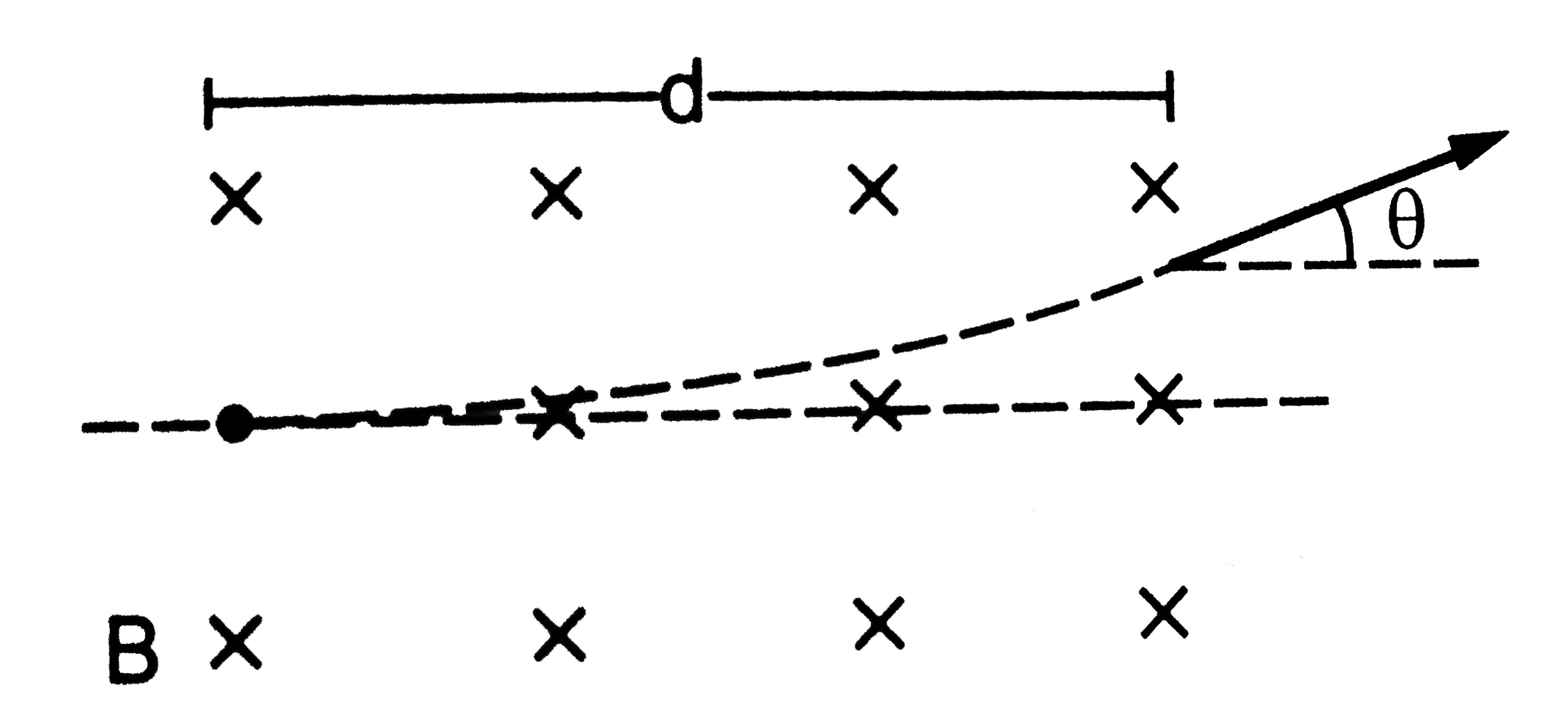A charged particle (q,m) enters perpendicular in a uniform magnetic field B and comes out field as shown. Find the angle of deviation θ for particle to cross magnetic field will be
 Solution in Tamil
Solution in Tamil
Mass of the particle =m .
char≥=q,
wh=d,
(a ) If d=mVqb
then d is equal the radius q is the angle between the radius and tangent which is equal to π2
(b ) if d=distancetravel≤d ,
12 of radius along x- distance
d=V0r
i, e, i=dVx .....(1)
vy=uy+ryl
From (i) putting the value of i,
tansinθ=12
⇒sinθ=tan−1(12)
=26.4=30∘=π6
(c ) The angle between the initial direction and final direction of velocity is π .
Topper's Solved these Questions
Similar Questions
If a charged particle at rest experiences no electromagnetic force, then electric field in that region
05:57View SolutionFind the range of frequency of light that is visible to an average human being (400nm<λ<700nm)
03:49View SolutionUsing the formulae ((→F)=(→qv)×(→B)andB=(μ0)i2πr,find the SI units of the magnetic field B and the permeability constant
02:13View SolutionA charged particle enters a uniform magnetic field with velocity v_(0) = 4 m//s perpendicular to it, the length of magnetic field is x = ((sqrt(3))/(2)) R , where R is the radius of the circular path of the particle in the field. Find the magnitude of charge in velocity (in m/s) of the particle when it comes out of the field.
06:46View SolutionA particle having mass m , charge q enters a cylindrical region having uniform magnetic field B in the inward direction as shown. If the particle is deviated by 60^(@) as it emerges out of the field then what is the time spent by it in the field?
View SolutionA charged particle enters a uniform magnetic field perpendicular to it. The magnetic field
View SolutionA charged particle (q, m) enters perpendicular in a uniform magnetic field B and comes out field as shown. The angle of deviation theta time taken by particle to cross magnetic field will be
01:34View SolutionA charge particle of charge 'q' and mass 'm' enters in a given magnetic field 'B' and perpendicular to the magnetic field as shown in the figure. It enters at an angle of 60^(@) with the boundary surface of magnetic field and comes out at an angle of 30^(@) with the boundary surface of the magnetic field as shown in the figure. Find width 'd' in which magnetic field exist.
03:39View SolutionA positive charge particle of charge q, mass m enters into a uniform magnetic field with velocity v as shown in the figure. There is no magnetic field to the left of PQ. Find distance travelled in the magnetic field
01:44View SolutionIf a charged particle enters perpendicular in the uniform magnetic field then
04:21View Solutionएक आवेशित कण, चुम्बकीय क्षेत्र रेखाओं के साथ 85∘ का कोण बनाते हुए एकसमान चुम्बकीय क्षेत्र में प्रवेश करता है। कण का पथ एक वृत्त है।
04:14View SolutionA charged particle of charge q and mass m is shot into a uniform magnetic field of induction B at an angle θ with the field. The frequency of revolution of the particle
01:36View Solutionद्रव्यमान m व आवेश q का एक कण एक समान चुम्बकीय क्षेत्र में v वेग से क्षेत्र की दिशा के लम्बवत् प्रवेश करता है। कण का घूर्णन काल
06:20View SolutionA charge particle of charge 'q' and mass 'm' enters in a given magnetic field 'B' and perpendicular to the magnetic field as shown in the figure. It enters at an angle of 60^(@) with the boundary surface of magnetic field and comes out at an angle of 30^(@) with the boundary surface of the magnetic field as shown in the figure. Find width 'd' in which magnetic field exist.
02:40View SolutionA particle of mass m and charge q is projected into a region having a perpendicular magnetic field B. Find the angle of deviation fo the particle as it comes out of the magnetic field if the width d of the regions is very smaller then
 01:58View Solution
01:58View SolutionA charged particle enters a uniform magnetic field with velocity v0=4m/s perpendicular to it, the length of magnetic field is x=(√32)R, where R is the radius of the circular path of the particle in the field. Find the magnitude of charge in velocity (in m/s) of the particle when it comes out of the field.
02:23View Solution

